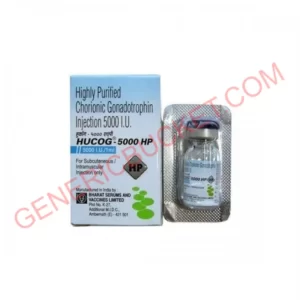Ginette 35 Tablet (Cyproterone 2mg / Ethinyl Estradiol 0.035mg)
$50.00 – $138.00
| Country of Origin | India |
|---|---|
| Dosage Form | Tablets |
| Equivalent Brand | Diane |
| Generic Name | Cyproterone / Ethinyl Estradiol |
| Indication | Polycystic ovary syndrome (PCOS) |
| Manufacturer | Cipla Ltd |
| Packaging | 21 tablets in 1 strip |
| Composition | Cyproterone (2mg) + Ethinyl Estradiol (0.035mg) |
| Pack Size | 42 Tablet/s, 84 Tablet/s, 126 Tablet/s |
| Ginette 35 Tablet (Cyproterone 2mg / Ethinyl Estradiol 0.035mg) | |||
| Pack Size | Price | Price/Unit | Add To Cart |
| 42 Tablet/s | $50.00 (1.19/unit) | $1.19 | |
| 84 Tablet/s | $95.00 (1.13/unit) | $1.13 | |
| 126 Tablet/s | $138.00 (1.1/unit) | $1.1 | |
What is Ginette 35 used for?
Ginette 35 tablets are used to treat women with severe signs of androgenisation (overproduction of androgen), that can produce conditions like hirsutism (unwanted hair) and androgenic alopecia (hair loss) both caused by excess androgen production. These conditions are often accompanied by acne, inflammation and seborrhoea (greasy skin from too much sebum). Ginette 35 tablets reduce the symptoms of androgen-dependent conditions where oral antibiotic or local treatment alone has not been successful. Ginette 35 tablets can also be used for oral contraception at the same time as they are being used to treat androgen-dependent conditions, however, they should not be used for contraception alone. Ginette 35 tablets can also be used for the treatment of polycystic ovary syndrome, which is also caused by excess androgen and is usually accompanied by acne and hirsutism.
How does Ginette 35 work?
Ginette 35 tablets contain a combination of ethinyloestradiol, a synthetic oestrogen, and cyproterone acetate, which is a derivative of progestogen and is also an antiandrogen. These two hormones work together to reverse the effects of too much androgen, while at the same time protecting against pregnancy. Although androgens, one of which is testosterone, are considered primarily male hormones, women also produce androgens, although in much lower amounts. Androgens have several functions in the female body, including puberty related changes like pubic hair growth, preventing bone loss, libido and for the production of oestrogen. However, some women produce too much androgen and this can cause hirsutism (unwanted hair) and other unwanted symptoms of androgen overproduction like acne and/or seborrhoea (greasy skin from too much sebum) and androgen-dependent alopecia. Cyproterone in Ginette 35 tablets blocks the production of androgens by the ovaries and binds to the androgen receptors on specific cells in the pilosebaceous unit in the skin, containing sebum glands and hair follicles, blocking the action of androgens like over stimulation of sebum and over production of hair. The ethinyloestradiol component enhances the effect of cyproterone by reducing the amount of androgens in the circulation, relieving symptoms like acne and hirsutism. The combination of a progestagen (cyproterone) and an oestrogen (ethinyloestradiol) in Ginette 35 tablets, provides effective contraception, by blocking ovulation, preventing development of the endometrium so that a fertilised egg would not be able to implant and grow, and preventing the thinning of cervical secretions so that sperm cannot get through.
What does Ginette 35 contain?
Ginette 35 tablets contain a combination of ethinyloestradiol (0.035 mg), a synthetic oestrogen, and cyproterone acetate (2 mg), which a progestogen and also an antiandrogen, which work together to reverse the effects of too much androgen, while at the same time protecting against pregnancy. The colour is due to quinoline yellow and titanium dioxide
Treating acne with Ginette 35
Ginette 35 tablets contain a combination of ethinyloestradiol, a synthetic oestrogen, and cyproterone acetate, which is a derivative of progestogen and is also an antiandrogen. These two hormones work together to reverse the effects of too much androgen. Although androgens, are primarily male hormones (like testosterone) women also produce androgens, although in much lower amounts, which are needed for puberty related changes like pubic hair growth, preventing bone loss, libido and for the production of oestrogen. However, some women produce too much androgen and this can cause over production of sebum (oil produced by sebum glands in the skin) which blocks hair follicles causing acne and/or seborrhoea (greasy skin from too much sebum). Cyproterone in Ginette 35mg tablets blocks the production of androgens by the ovaries and binds to the androgen receptors on specific cells in the pilosebaceous units in the skin, containing sebum glands and hair follicles, blocking the over stimulation of sebum and over production of hair by the action of androgens. The ethinyloestradiol component enhances the effect of cyproterone by reducing the amount of androgens in the circulation, relieving symptoms like acne.
Ginette 35 for contraception
Ginette 35 tablets contain a combination of ethinyloestradiol, a synthetic oestrogen, and cyproterone acetate, which is a derivative of progestogen and is also an antiandrogen. These two hormones work together to reverse the effects of too much androgen, while at the same time protecting against unwanted pregnancy. The combination of a progestagen (cyproterone) and an oestrogen (ethinyloestradiol) in Ginette 35 tablets, provides effective contraception, by blocking ovulation, preventing development of the endometrium so that a fertilised egg would not be able to implant and grow, and preventing the thinning of cervical secretions so that sperm cannot get through.
Ginette 35 for transgender hormone therapy
Ginette 35 tablets contain a combination of ethinyloestradiol, a synthetic oestrogen, and cyproterone acetate, which is a derivative of progestogen and is also an antiandrogen. The cyproterone component can be used as a substitute for spironolactone as the antiandrogen component of transgender feminising hormone therapy for male to female transsexuals, if small doses of antiandrogen are required.
What are the side effects of Ginette 35?
The most frequently reported side effects when taking Ginette 35mg tablets are: breast tenderness, breast pain, abdominal pain, nausea, oedema, and headache, skin rash and itching, insomnia and depression. Less common side effects include: migraine, fluid retention, changes in body weight, changes in libido.
When should Ginette 35 not be used?
You should not use Ginette 35 if you:
- are taking another form of oral contraception, as Ginette 35 inhibits ovulation and therefore prevents conception
- are allergic to ethinyloestradiol or cyproterone or any of the ingredients in Ginette 35 tablets
- have a past or family history of carcinoma of the breast, endometrial carcinoma or liver disease
- have high blood pressure, lipid disorders or migraine
- have had deep venous thrombosis, thromboembolic disorders, heart attack or stroke
- have diabetes with changes to the blood vessels
- are a diabetic taking antidiabetics or insulin, without discussion with your doctor, as the cyproterone in Ginette 36 tablets may affect your glucose tolerance
- abnormal genital bleeding of unknown cause
- are pregnant or planning to become pregnant
- are taking other medications that may interact with Ginette 35mg, such as anticonvulsants like phenytoin and carbamazepin, barbiturates, anti-infectives like rifampicin, rifabutin, nevirapine, the antifungal griseofulvin, antibiotics like penicillin, preparations containing St John’s Wort
What are the health risks of Ginette 35?
Combination contraceptive pills like Ginette 35 can increase risk of thrombosis (blood clots), which can have serious consequence depending on where the clot forms. There is also an increased risk of breast cancer.
How should Ginette 35 be taken?
While you are taking Ginette 35mg you should not use an additional hormonal contraceptive, as this will expose you to an excessive dose of hormones and is not necessary for effective contraception.
Each pack Ginette 35 contains 21 pills and you should take one tablet a day for 21 days and then you will have 7 days off, during which time you should have a menstrual bleed. When you have had the 7 tablet-free days, start a new pack the next day. If you have gastrointestinal problems like vomiting or diarrhoea within 3-4 hours of taking a tablet, this is the same as missing a pill and you should take other contraceptive precautions for the next 7 days. You should take Ginette 35 continually to ensure effective contraception. It may take several months for your skin condition to clear up completely and you should take Ginette 35 for as long as your doctor recommends.
How long should you take Ginette 35mg?
You should expect your acne to clear up completely within a few months, but in particularly severe cases treatment for longer may be necessary before the full benefit is seen. You may be advised to keep tasking your Ginette 35 tablets for a few more months after the acne has disappeared and you should then change to another oral contraceptive.
Missed dose of Ginette 35mg
If you miss a dose of Ginette 35mg and are less than 12 hours late in taking your tablet, take it as soon as you remember and take the next one at your usual time. You are still protected against pregnancy. If you are more than 12 hours late in taking your pill, take the last tablet as soon as you remember and take the next one at your normal time, which may mean taking 2 tablets in one day. Contraceptive protection may be reduced and you are at risk of becoming pregnant, unless you take other contraceptive precautions for the next 7 days.
How should Ginette 35mg be stored?
Keep your Ginette 35 tablets in their calendar pack until use. Store at room temperature below 25°C.
Related products
New Products
HCG Injections
New Products
New Products
New Products
Birth Control
New Products
New Products

















